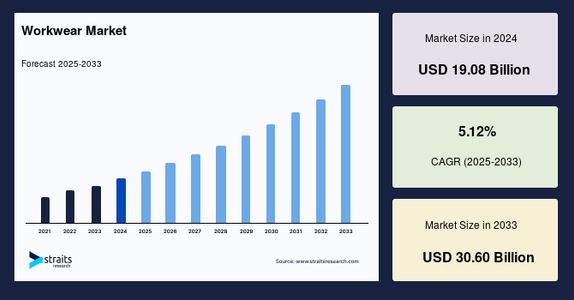Global Workwear Market: Trends, Drivers, and Future Outlook
 Tejask Kam
29 Aug, 2025
6 mins read
14
Tejask Kam
29 Aug, 2025
6 mins read
14

Introduction
The global workwear market encompasses clothing and accessories designed for employees across various industries to ensure safety, functionality, and professionalism. This includes protective gear for hazardous environments, uniforms for brand representation, and specialized attire for specific job functions. Workwear serves multiple purposes: safeguarding workers from occupational hazards, promoting company identity, and enhancing performance through comfort and utility.
Market Overview
The global workwear market size was valued at USD 19.08 billion in 2024 and is projected to grow from USD 20.06 billion in 2025 to USD 30.60 billion by 2033, exhibiting a CAGR of 5.12% during the forecast period (2025–2033).
Market Drivers
1. Emphasis on Workplace Safety and Regulatory Compliance
Heightened focus on occupational health and safety remains a major market driver. Stringent regulations across industries, particularly in construction, oil & gas, and manufacturing, necessitate the use of protective workwear to mitigate workplace hazards.
2. Industrialization and Infrastructure Development
Rapid industrialization and infrastructure development, especially in emerging economies, have increased the demand for durable and functional workwear. The expansion of sectors such as construction, manufacturing, and logistics contributes significantly to market growth.
3. Corporate Branding and Uniform Customization
Companies are increasingly investing in customized uniforms that reflect their brand identity. Uniforms serve as a marketing tool and foster a sense of unity among employees, enhancing corporate image and professionalism.
4. Technological Advancements in Workwear
Advancements in materials and technology have led to the development of smart workwear. Integrating smart technologies into workwear continues to transform the industry, driven by innovations in IoT, AI, and wearable sensors. For example, in August 2024, Honeywell introduced a line of connected safety wearables integrated with real-time monitoring for hazardous environments, used extensively in the oil & gas sectors.
Market Segmentation
By Product Type
- General Workwear: Standard attire suitable for various industries.
- Protective Workwear: Specialized clothing designed to protect against specific hazards.
- Corporate Workwear: Uniforms tailored to reflect company branding and professionalism.
By End-Use Industry
- Manufacturing: Includes apparel for factory workers and assembly line staff.
- Construction: Heavy-duty clothing designed for construction sites.
- Oil & Gas: Specialized attire for workers in the oil and gas industry.
- Healthcare: Medical uniforms and scrubs for healthcare professionals.
- Hospitality: Uniforms for staff in hotels, restaurants, and related establishments.
By Distribution Channel
- Direct Sales: Purchases made directly from manufacturers.
- Retail Stores: Physical stores selling workwear products.
- E-commerce Platforms: Online platforms facilitating the sale of workwear.
Regional Analysis
- Asia-Pacific: The largest market share is held by the Asia-Pacific region, driven by manufacturing hubs in countries like China and India .
- North America: The fastest-growing market, with increasing demand for smart workwear and stringent safety regulations.
- Europe: Steady growth due to established industries and regulatory frameworks.
- Middle East & Africa: Emerging markets with growing industrial sectors.
- Latin America: Developing markets with increasing infrastructure projects.
Challenges
- Cost of Advanced Materials: The integration of smart technologies and high-quality materials increases production costs, potentially limiting affordability for small and medium enterprises.
- Regulatory Compliance: Adhering to diverse safety standards across regions can be complex for multinational companies.
- Supply Chain Disruptions: Global events and geopolitical tensions can disrupt the supply chain, affecting the availability of raw materials and finished products.
Future Outlook
The workwear market is poised for continued growth, driven by technological advancements, increasing industrial activities, and a focus on safety and branding. Innovations in materials, such as flame-resistant fabrics and moisture-wicking textiles, will enhance the functionality and comfort of workwear. The integration of smart technologies, including wearable sensors and real-time monitoring systems, will further revolutionize the industry, improving safety and operational efficiency.
Conclusion
The global workwear market is experiencing significant growth, fueled by industrialization, technological advancements, and a heightened focus on safety and branding. As industries evolve, the demand for specialized, functional, and smart workwear will continue to rise, presenting opportunities for innovation and expansion in the sector.
Written By:
Tejask Kam



Hotels at your convenience
Now choose your stay according to your preference. From finding a place for your dream destination or a mere weekend getaway to business accommodations or brief stay, we have got you covered. Explore hotels as per your mood.





